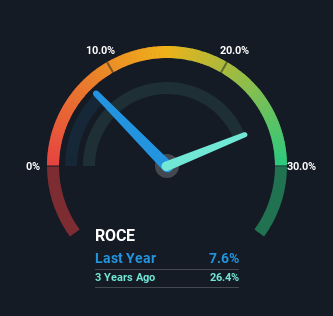Stock Analysis
- Saudi Arabia
- /
- Professional Services
- /
- SASE:1831
Returns On Capital Signal Tricky Times Ahead For Maharah for Human Resources (TADAWUL:1831)

If you're not sure where to start when looking for the next multi-bagger, there are a few key trends you should keep an eye out for. One common approach is to try and find a company with returns on capital employed (ROCE) that are increasing, in conjunction with a growing amount of capital employed. If you see this, it typically means it's a company with a great business model and plenty of profitable reinvestment opportunities. Although, when we looked at Maharah for Human Resources (TADAWUL:1831), it didn't seem to tick all of these boxes.
Return On Capital Employed (ROCE): What Is It?
For those who don't know, ROCE is a measure of a company's yearly pre-tax profit (its return), relative to the capital employed in the business. Analysts use this formula to calculate it for Maharah for Human Resources:
Return on Capital Employed = Earnings Before Interest and Tax (EBIT) ÷ (Total Assets - Current Liabilities)
0.076 = ر.س94m ÷ (ر.س1.8b - ر.س597m) (Based on the trailing twelve months to March 2024).
Thus, Maharah for Human Resources has an ROCE of 7.6%. Ultimately, that's a low return and it under-performs the Professional Services industry average of 22%.
View our latest analysis for Maharah for Human Resources

Above you can see how the current ROCE for Maharah for Human Resources compares to its prior returns on capital, but there's only so much you can tell from the past. If you'd like to see what analysts are forecasting going forward, you should check out our free analyst report for Maharah for Human Resources .
What Does the ROCE Trend For Maharah for Human Resources Tell Us?
When we looked at the ROCE trend at Maharah for Human Resources, we didn't gain much confidence. To be more specific, ROCE has fallen from 42% over the last five years. Although, given both revenue and the amount of assets employed in the business have increased, it could suggest the company is investing in growth, and the extra capital has led to a short-term reduction in ROCE. If these investments prove successful, this can bode very well for long term stock performance.
On a related note, Maharah for Human Resources has decreased its current liabilities to 33% of total assets. That could partly explain why the ROCE has dropped. What's more, this can reduce some aspects of risk to the business because now the company's suppliers or short-term creditors are funding less of its operations. Since the business is basically funding more of its operations with it's own money, you could argue this has made the business less efficient at generating ROCE.
The Bottom Line
In summary, despite lower returns in the short term, we're encouraged to see that Maharah for Human Resources is reinvesting for growth and has higher sales as a result. In light of this, the stock has only gained 8.3% over the last five years. Therefore we'd recommend looking further into this stock to confirm if it has the makings of a good investment.
On a final note, we found 3 warning signs for Maharah for Human Resources (1 shouldn't be ignored) you should be aware of.
While Maharah for Human Resources isn't earning the highest return, check out this free list of companies that are earning high returns on equity with solid balance sheets.
New: Manage All Your Stock Portfolios in One Place
We've created the ultimate portfolio companion for stock investors, and it's free.
• Connect an unlimited number of Portfolios and see your total in one currency
• Be alerted to new Warning Signs or Risks via email or mobile
• Track the Fair Value of your stocks
Have feedback on this article? Concerned about the content? Get in touch with us directly. Alternatively, email editorial-team (at) simplywallst.com.
This article by Simply Wall St is general in nature. We provide commentary based on historical data and analyst forecasts only using an unbiased methodology and our articles are not intended to be financial advice. It does not constitute a recommendation to buy or sell any stock, and does not take account of your objectives, or your financial situation. We aim to bring you long-term focused analysis driven by fundamental data. Note that our analysis may not factor in the latest price-sensitive company announcements or qualitative material. Simply Wall St has no position in any stocks mentioned.
Have feedback on this article? Concerned about the content? Get in touch with us directly. Alternatively, email editorial-team@simplywallst.com
About SASE:1831
Maharah for Human Resources
Provides manpower services to public and private sectors in Saudi Arabia and the United Arab Emirates.
High growth potential with mediocre balance sheet.

